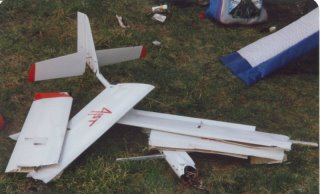
Before you are allowed to fly a sailplane [glider] solo you have to be tested on your ability to recover from a stall. The test is conducted as follows. The trainee pilot and an instructor go up in a two-seater to what the instructor hopes is a safe height.
The instructor then takes control and pulls back sharply on the stick. This disrupts the airflow over the wings and the sailplane starts to stall. At first it falls backwards, but soon the nose goes down, and the plane goes into a steep dive. This happens in a few seconds. In a few seconds more one wing falls away and the sailplane starts to spin. The plane is now losing height rapidly.
The instinctive response is to pull back on the stick. This is wrong and inevitably fatal. The correct thing to do is to push the stick forward and increase the dive angle. This increases the airspeed even more, but it also increases the airflow over the wings and gives you control. When you have control again, you can straighten the wings and pull back on the stick so that you come out of the dive. The secret is to pull back enough to avoid impact with the ground, but not so much that the wings come off.
In the early days of flight quite a few people were killed in stalls before someone discovered the secret of recovery.
In ‘The Right Stuff’ about the early astronauts Tom Wolfe describes what test pilots [most of the first generation of American astronauts had been test pilots] do when something goes wrong. First they try procedure A, then they try procedure B, then they try procedure C, and so on, until one works, or they die.
That is also my philosophy for dealing with tricky problems and it has kept me alive so far. That and a good and cautious eye for calculating risk. However, the A, then B and so on approach does not always work.
One way of launching a sailplane is for a powered aircraft to tow it to a height where it can pick up its own lift. If the sailplane pilot is inexperienced, and the tow pilot not very careful, the sailplane can fall below the tow plane. This has the effect of pulling down the tail of the tow aircraft and putting it into a stall.
The trick for avoiding this is for the tow pilot to release the tow cable as soon as he thinks it is happening. One pilot I knew didn’t do that fast enough and the tow aircraft went into a stall. He was a very experienced pilot whose full time job was flying fighters out of RAF Leuchers in Scotland. I am sure he tried all the possibilities on the way down, but the plane he was flying needed at least nine hundred feet to pull out of a stall. He had seven hundred.
1 comment:
"...The trainee pilot and an instructor go up in a two-seater to what the instructor hopes is a safe height.
The instructor then takes control and pulls back sharply on the stick. This disrupts the airflow over the wings and the sailplane starts to stall. At first it falls backwards, but soon the nose goes down, and the plane goes into a steep dive. This happens in a few seconds. In a few seconds more one wing falls away and the sailplane starts to spin rapidly. This is unpleasant. The plane is now losing height very rapidly...."
I'm sorry but this is totally bogus. A stalled sailplane does not fall backwards. Typically, the nose simply drops, the glider regains airspeed, ans then you just raise the nose to level attitude. No big deal. It Is possible to spin a glider from a stall but it is not normal, it's fun and no big deal - at altitude.
I've been training sailplane pilots for 12 years. I wouldn't kid you. See my web site at http://home.comcast.net/~verhulst/SOARING
Tony
Post a Comment